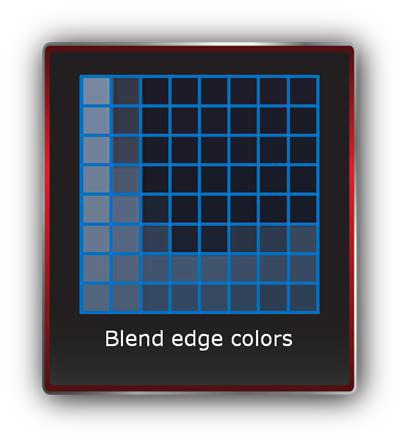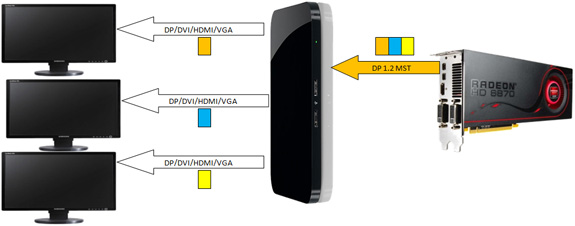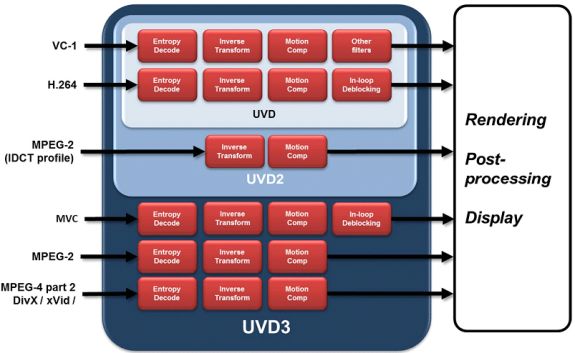AMD's Radeon HD 6970 & Radeon HD 6950: Paving The Future For AMD
by Ryan Smith on December 15, 2010 12:01 AM ESTRefresher: The 6800 Series’ New Features
Back in October AMD launched the first 6000 series cards, the Barts-based Radeon HD 6800 series. At their core they are a refreshed version of the Cypress GPU that we saw on the 5800 series, but AMD used the opportunity to make some enhancements over the standard Cypress. All of these enhancements apply throughout the 6000 series, so this includes the 6900 series. As such for those of you who didn’t pay much attention to the 6800 series, we’re going to quickly recap what’s new in order to lay the groundwork for further comparisons of the 6900 series to the 5800 series.
We’ll start with the core architecture. Compared to Cypress, Barts is nearly identical save 1 difference: the tessellator. For Barts AMD implemented what they call their 7th generation tessellator, which focused on delivering improved tessellation performance at lower tessellation factors that AMD felt were more important. Cayman takes this one step further and implements AMD’s 8th generation tessellator, which as the naming conventions implies is the 7th generation tessellator with even further enhancements (particularly those necessary for load balancing).
The second change we saw with Barts and the 6800 series was AMD’s refined texture filtering engine. AMD’s texture filtering engine from the 5800 set new standards by offering angle independent filtering, but it had an annoying quirk with highly regular/noisy textures where it didn’t do a good enough job blending together various mipmaps, resulting in visible transitions between them. For the 6800 series AMD fixed this, and it can now properly blend together noisy textures. At the same time in a controversial move AMD tweaked its default filtering optimizations for the 5800 series and entire 6000 series, leading to these cards producing imagines subtly different (and depending on who you ask, subtly worse) than they were on the 5800 series prior to the Catalyst 10.10 drivers.

| Radeon HD 5870 | Radeon HD 6870 | GeForce GTX 480 |
The third change we saw was the introduction of a new anti-aliasing mode, initially launched on the 6800 series and backported to the 5800 series shortly thereafter. Morphological Anti-Aliasing (MLAA) is a post-processing filter that works on any (and all) images, looking for high contrast edges (jaggies) and blending them to reduce the contrast. Implemented as a compute shader, it works with all games. As it’s a post-processing filter the results can vary – the filter has no knowledge of depth, polygons, or other attributes of the rendered world beyond the final image – so it’s prone to blending everything that looks like aliasing. On the plus side it’s cheap to use as it was originally designed for consoles with their limited resources, so by not consuming large amounts of memory & memory bandwidth like SSAA/MSAA it usually has a low performance hit.


Last but not least, AMD made a number of changes to their display hardware. The Universal Video Decoder (UVD) was upgraded to version 3, bringing full decode support for MPEG-2, MPEG-4 ASP, and H.264 MVC (packed frame video for 3D movies). For the 6900 series this is not of great importance as MPEG-2 and MPEG-4 ASP are low complexity codecs, but it does play an important role for AMD’s future APU products and low-end GPUs, where offloading these low complexity codecs is still going to be a big relief for the slower CPUs they’re paired with. And on that note the first public version of the DivX codec with support for UVD3 will be shipping today, letting 6800/6900 series owners finally take advantage of this functionality.
The second of the major display changes was the addition of support for the DisplayPort 1.2 standard. DP1.2 doubles DisplayPort’s bandwidth to 21.6Gbps, finally giving DisplayPort a significant bandwidth lead over dual-link DVI. With double the bandwidth it’s now possible to drive multiple monitors off of a single root DisplayPort, a technology called Multi Stream Transport (MST). AMD is heavily banking on this technology, as the additional bandwidth coupled with the fact that DisplayPort doesn’t require a clock source for each monitor/stream means AMD can drive up to 6 monitors off of a single card using only a pair of mini-DP ports. AMD is so cutting edge here that like the 6800 series the 6900 series is technically only DP1.2 ready – there won’t be any other devices available for compliance testing until 2011.

Finally, the 6800 series also introduced support for HDMI 1.4a and support for color correction in linear space. HDMI 1.4a support is fairly straightforward: the 6000 series can drive 3D televisions in either the 1080p24 or 720p60 3D modes. Meanwhile support for color correction in linear space allows AMD to offer accurate color correction for wide gamut monitors; previously there was a loss of accuracy as color correction had to be applied in the gamma color space, which is only meant for use for display purposes. This is particularly important for integrating wide gamut monitors in to traditional gamut workflows, as sRGB is misinterpreted on a wide gamut monitor without color correction.
While all of these features were introduced on the 6800 series, they’re fundamental parts of the entire 6000 series, meaning they’re part of the 6900 series too. This provides us with a baseline set of improvements over AMD’s 5800 series, on top of the additional improvements Cayman and AMD’s VLIW4 architecture brings.











168 Comments
View All Comments
versesuvius - Friday, December 17, 2010 - link
Ananke,I am not very knowledgeable about this, but I don't think a modern GPU can fit inside a CPU for now. A better idea would be a console on a card. The motherboards on the consoles are not much bigger than the large graphic cards of today. A console card for $100 would be great. I am sure that there is no technical obstacles that the average electronic wizard cannot overcome, doing that.
Sure, there is a use for everything. I can imagine that every single human being on earth can find a use for a Ferrari, but the point is that even those who do have it, do not use it as often as their other car, (Toyota, VW or whatever). In fact, there is rarely a Ferrari that has more than 20,000 km on it, and even that is put on it by successive owners, not one. The average total an ordinary person can stand a Ferrari is 5000 KM. (Disclaimer: I do not have one. I only read something to that effect somewhere). Having said that, I do have a sense of the "need for speed". I can remember sitting in front of the university's 80286 waiting for the FE program to spit out the results, one node at a time, click, click, ... . You have millions of polygons, we can have billions of mesh nodes, and that even does not even begin to model a running faucet. How's that for the need for speed. I do appreciate the current speeds. However, the CPU deal was and is a straight one. The graphic card deals, today, are not. To be clear, the "and" in "High End"s and "Fool"s is an inclusive one. "Someone will pay for it", was also initiated in the eighties of the last century. By the way, the big question "can it play crysis", will no longer be. Crysis 2 is coming to the consoles.
Quidam67 - Friday, December 17, 2010 - link
"But can it play Crysis" should be in the Urban dictionary as a satirical reference on graphics code that combines two potent attributes: 1) is way ahead of its time in terms of what current hardware can support 2) is so badly written and optimised that even hardware that should be able to run it still can't.In 1000 years time when Organic Graphics cards that you can plug into your head still can't run it smoothly @2560*1600 60fps they will realise the joke was on us and that the code itself was written to run more and more needless loops in order to overwhelm any amount of compute-resource thrown at it.
Iketh - Friday, December 24, 2010 - link
LOLmarc1000 - Friday, December 17, 2010 - link
I swear I've read ALL the comments to see if anyone already pointed it... but no one did.I feel a bit disappointed with this launch too (I have a 5770 and wanted to get 6950 but was wanting a bigger increase %-wise). But one thing interesting it the number of Stream Processors in the new gpus. By the "pure processor" count this number decreased from 1600 SPs on 5870 to 1536 SPs on 6970. But the size of the VLIW processors changed too. It was 5 SPs on 5870 and now is 4 SPs.
So we have:
hd5870 = 1600 SPs / 5 = 320 "processors"
hd6970 = 1536 SPs / 4 = 384 "processors"
if we take that 384 and multiply by 5, we would have 1920 SPs on the new generation (on par with many rumors). this is 20% more shaders. and considering AMD is saying that the new VLIW4 is 10% faster than VLIW5 we should have more than 20% increase in all situations. but this is only true in the minority of tests (like crysis at 2560x1660 where it is 24%, but in the same game at 1680x1050 the increase is only 16%). and at the same time the minimun FPS got better, yet in another games the difference is smaller.
but then again, I was expecting a little more. I believe the 6950 will be a worthy upgrade to me, but the expectations were so high that too much people ended a little disappointed... myself included.
Sunburn74 - Tuesday, December 28, 2010 - link
Well... at least they delivered on time and didn't make you wait 6 more months to simply deliver an equivalent, if not considerably worse, product.Mr Perfect - Friday, December 17, 2010 - link
Yes, the minimums are appreciated when they're included.It would be even better if the framerates was displayed as a line graph instead of a bar graph. That way readers could tell if an average consisted of a lot of high peaks and low valleys, or really was a nice smooth experience all the way through. Some other review sites use linegraphs and while I visit Anandtech for it's timeliness, professionalism, industry insight and community involvement, I go to the other sites for the actual performance numbers.
Quidam67 - Friday, December 17, 2010 - link
There is further rationale for splitting the article. Lets say someone is googling "HD 6970 architecture" perhaps they will pick up this review, or perhaps they won't, but either way, if they see that it is actually a review on the cards, they might be inclined to bypass it in favour of a more focused piece.And again, there is no reason why the Architecture Article can't provide a hyperlink to the review, if the reader then decides they want to see how that architecture translates into performance on the current generation of cards supporting it.
I really hope AT are reading this and giving it some consideration. As you say, they are a great sight and no one is disputing that, but it's not a religion, so you should be allowed to question it without being accused of blasphemy :O)
dustcrusher - Friday, December 17, 2010 - link
It really comes down to how important the mainstream market is. If they are a large enough segment of the market, one company using a simple, easy-to-grasp naming convention would likely grab some market share. Make it easy to buy your product and at least some people will be more likely to do so.If not, then it's fun to talk about but not terribly important. Tech-savvy folk will buy whatever meets their needs price/performance-wise after doing research, even if a card is named the Transylvania 6-9000 or the Wankermeister GTFO. Eager to please tech-naive folk are going to buy the largest model number they can get with the money they have, because "larger model numbers = bigger/better equipment" is a long-established consumer shorthand.
I have a half-baked idea for a model numbering system that's based around the key specs of the card- it's a 5 digit system where the first digit is the hardware platform ID (like what we have now, mostly) and the other four would represent combinations of other specs (one digit could be the lowest memory clock speed and bus width would be 1, the next lowest memory clock speed and lowest bus width would be 2, etc).
No idea if this could actually be implemented- there are probably too many variables with GPU/memory clock speeds, among other things.
Shinobi_III - Saturday, December 18, 2010 - link
If you ever saw Nvidia 4xAA in action, you know it's not as smooth as the radeon implementation (especially in motion) and z-buffer miscalculations has always been a nvidia feature.Go up a hill in Fallout New Vegas and look at Vegas in the horizon, with Nvidia cards it always looks like a disco due to meshes overlapping. Now do the same on Radeon.
TheUsual - Saturday, December 18, 2010 - link
Right now, Newegg has a 6870 for $200 after rebate. Two of these makes for an awesome value at $400. The top tier of cards doesn't give a corresponding increase in performance for the extra cost. Two 6950s costs 50% more but does not give you 50% more FPS. Two GTX 460 1GBs is also a great bang for the buck at $300.Neither of these lets you do triple SLI/XFIRE however. That would be what would be paying extra for.
My hope is that the price will drop on the 6950 by around February. By then the GTX 560 should be out and might drive prices down some. The benchmarks could change some with Sandy Bridge too, if they are currently CPU bound.